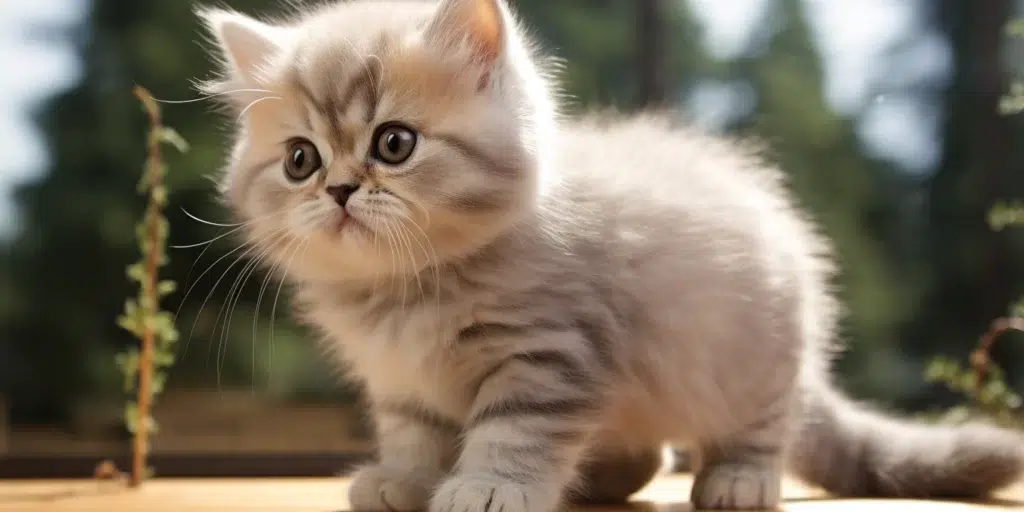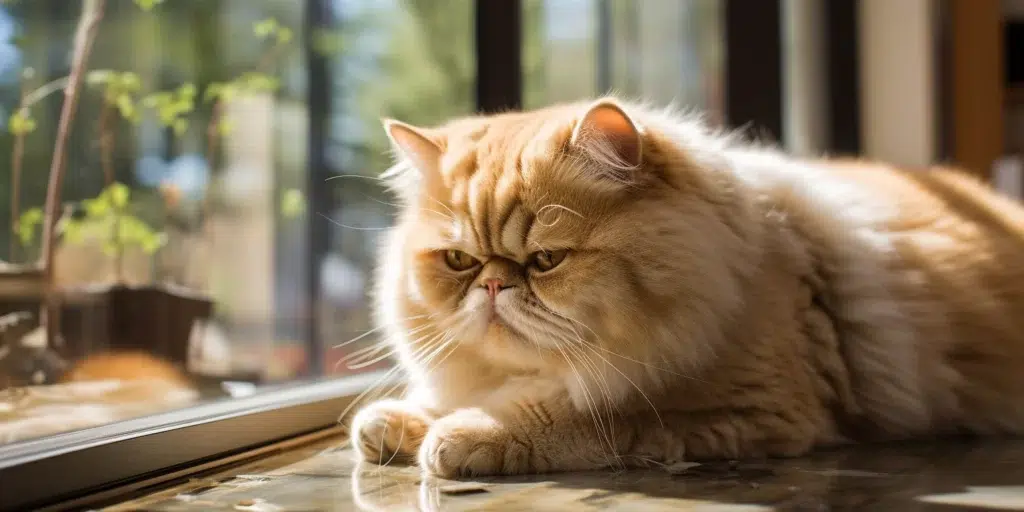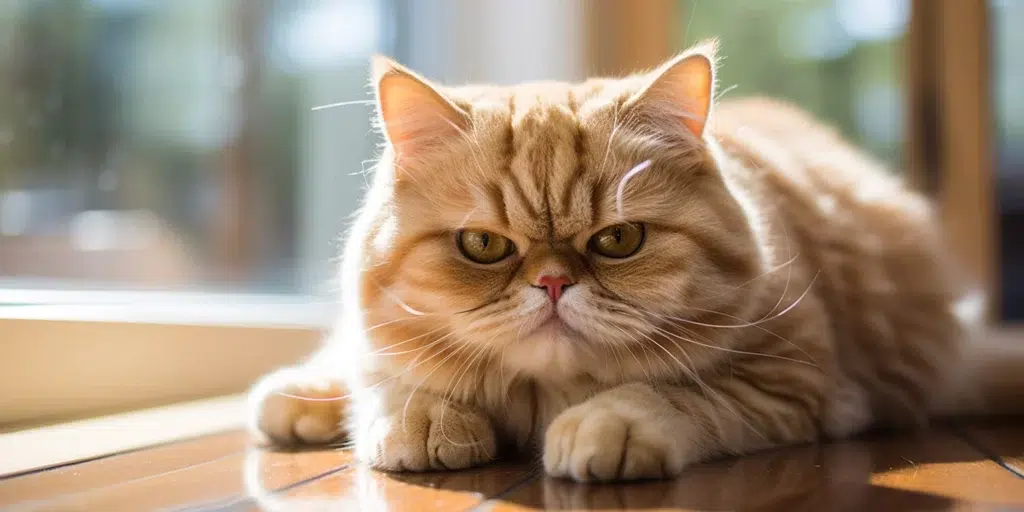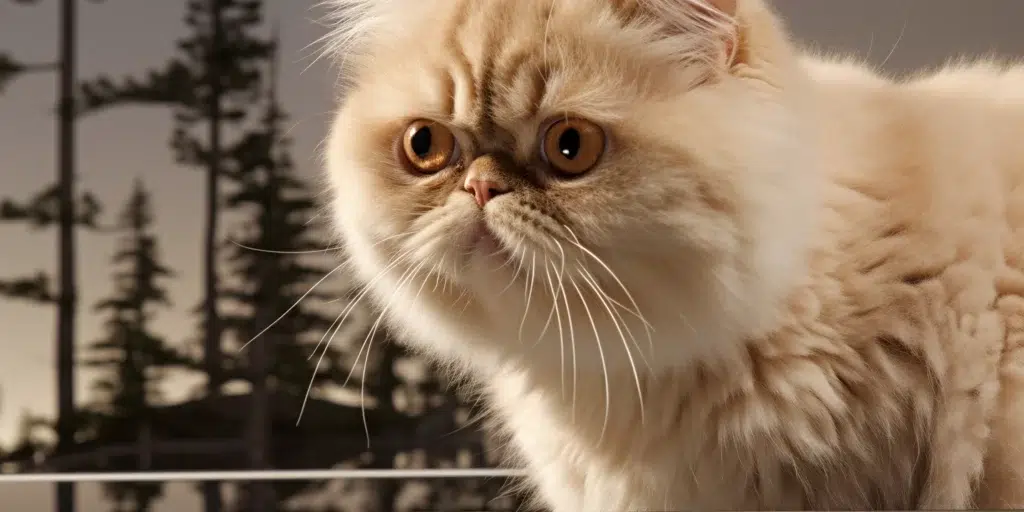Exotic shorthairs are a great choice for those looking for the look of a Persian without all the hassle of grooming! These adorable cats have a sweet and gentle demeanor, making them an ideal pet for anyone who loves cats but may not have the time.
Their short and dense coat is easy to maintain, and in return, you get their pansy-like face with big eyes and a cuddly body that make them perfect lap cats.
These lovely cats can bring so much joy into your life with the right care! Exotics are often more reserved than other breeds, but they still need enough exercise and mental stimulation, so make sure to play with them often!
This article covers all the basics and advanced care needs of the Exotic Shorthair, as well as many more pieces of advice to help you become a successful owner.

Introduction to the Exotic Shorthair Breed
The Exotic Shorthair is among the most beloved cat breeds, renowned for its unique looks and wonderful personality. Sharing traits with other Persian Breed Group members, this particular feline stands out with its own distinct characteristics.
Their charming flat faces and plush cheeks make them irresistible companions in many households. If you’re considering an addition to your family, learning about the sweet nature of the Exotic shorthair could sway your decision.
Exotic shorthairs lack the long fur of their Persian relatives, which means less grooming for you! Their compatibility with everyone makes them perfect for homes looking for a social and cuddly pet.
The tale of the Exotic Shorthair’s origin is fascinating, starting with breeders’ ambitions to infuse American Shorthairs with the elegant features of Persians. Initial crosses were visually appealing but didn’t quite hit the mark. Breeders were trying to create a cat like the Persian but with a short, fluffy coat.
Starting with one color, these silver-coated beauties now come in a stunning palette of colors. The early journey for this breed wasn’t easy, as convincing was needed to bring Persian breeders on board for this innovative endeavor.
Since its introduction in 1979, the Exotic Shorthair has been winning over cat lovers and proving itself to be a true feline champion. Its popularity grew over time as it took on more of the Persian’s distinctive look. Eventually, the only difference between the two breeds was the length of their coats.
Related: American Cat Breeds That Define the U.S. Feline Fancy
Identifying Exotic Shorthair Cat
The appearance of an exotic shorthair cat is defined by its wide head, small ears, large round eyes, square build, short, thick legs and tails, and luxurious short coat. This breed may be found in a rainbow of colors and patterns, and its short hair means that it requires very little maintenance in terms of grooming.
They have sturdy bodies and powerful bones that make them look like cuddly toys, and their friendly faces make them wonderful pets for anyone seeking a loving feline companion.

Whether you are looking for a traditional cat color (white, black, or red) or something a little more exotic (lilac, golden, or chocolate); exotic shorthair cats are available in a rainbow of patterns and colors to fit every taste.
Personality Traits
Exotic shorthairs are known for their quiet and gentle temperament, making them suitable for calm households. They enjoy affection but aren’t demanding, fitting in well with families and other pets. If you want a serene and loving cat, then this breed could be the perfect match.
Exotic shorthairs are fantastic pets for families with kids and other pets because they are friendly, energetic, and full of energy. They are also great with kids because they are calm and will lay close to them without being too possessive.
Playing with toys or other animals is something the Exotic Shorthair loves to do. This breed especially adores dogs, and you can frequently see them playing with or cuddling up with other pets.
Activity Level
Exotic shorthair cats have a relatively low activity level. They are calm and not as active or energetic as other breeds. These cats prefer to lounge around the house and nap for much of the day if given the opportunity.
They are not the best lap cats, but don’t be surprised if you find your Exotic Shorthair curled up in your lap. Despite their low energy levels, these cats can still be very playful and affectionate when they feel like it.
Physical activity at regular intervals throughout the day is essential for the health and happiness of exotic shorthairs, even if they may not seem to need much exercise.
Take some time each day for playtime; this will provide mental stimulation for your cat, helping him stay sharp and mentally engaged while burning off extra calories.

Exotic Shorthair Cat Loyalty
Exotic shorthairs are one of the most loyal and affectionate cat breeds around. They are known for their quiet nature, sweet personalities, and strong bonds with their owners. These cats form deep connections with members of the family and will often be found walking around their humans.
Love Of Water
Exotic Shorthair loves water and enjoys taking baths, which is beneficial for their fur health. They should be introduced to water and bathing at a young age so they get used to it.
Because of its flatter face, the exotic shorthair’s eyes tend to tear and stain the surrounding fur. Bathing should be done regularly to ensure that their coat stays clean and healthy. After bathing, it’s important to use a blow dryer to help keep their fur from matting or tangling.
Trainability
Exotic shorthair cats are known for their sweet and affectionate personalities, which make them great companions for a variety of lifestyles. While they may not be as active or agile as some other breeds, these cats have an impressive level of trainability.
With the right amount of patience and dedication, exotics can learn a few different tricks. This breed also tends to retain what they have learned for longer periods of time than most other cat breeds.
Adult Size
Exotic shorthairs are medium-to-large cats. Males tend to be larger than females in terms of height, weight, and length.
The height for an Exotic Shorthair cat is 10–12 inches when standing on all fours. On average, they weigh between 7 and 13 pounds, depending on gender and age. Males are usually on the larger end of the scale and look much more muscular.
In terms of length, they typically reach 16–19 inches long. This makes them look much larger than they actually are.
An exotic shorthair typically reaches its full size by the age of 12 to 14 months. Throughout this growth period, kittens undergo various physical changes, progressively gaining weight and stature until they mature into adulthood. Individual growth rates can vary based on factors such as genetics, diet, and overall health.
After this point, their growth rate significantly slows down, and most will remain at their full “adult size” for the rest of their lives. Though it is important to provide them with a balanced diet to prevent obesity in your exotic cat.

Life Expectancy
The Exotic Shorthair is a very robust breed of cat that can be expected to lead a long and healthy life. With proper care and attention, these cats can easily reach 8–15 years.
To ensure your Exotic Shorthair lives the longest and happiest life possible, it is important to provide them with a nutritious diet, regular exercise, and plenty of love!
Exotic Shorthair Cat Care
Exotic shorthair cats are easy to take care of. The first and foremost thing you should do is brush your cat’s fur regularly. This will eliminate dirt, dead hair, and excess shedding.
It also helps to keep the coat shiny and healthy-looking. A weekly brush should be enough to keep their coats looking great. But more frequent brushing can help lower the fur amount on your furniture.
Exotic shorthairs require regular baths to prevent skin problems, especially on the face. Because of their flat faces, the water coming out of their eyes might cause skin issues or tears. This is why its important to groom and bathe them regularly.
Use the cat shampoo that a veterinarian has recommended for bathing. When bathing your cat, use only lukewarm water and a cat shampoo too avoid irritating the skin or stripping essential oils from the fur coat.
Don’t forget about playtime! Exercise keeps cats fit, both physically and mentally. So make sure you provide them with toys that they can play around with.
Diet
Exotic Shorthair requires a nutrition-rich diet to stay healthy and active. As an owner of this breed, it’s important to understand their dietary needs to best provide for them.
The most important thing when choosing food for an exotic shorthair is that it should be rich in protein from animal sources. This ensures your cat will get the essential amino acids they need to keep their coat soft and shiny, as well as maintain strong muscles.
It is preferable if the food does not contain grains, as these can aggravate gastrointestinal problems in cats with food allergies or sensitivities.

When selecting food, make sure you check the ingredient list carefully so you know exactly what you’re feeding your cat.
Look for clearly named meats like chicken or beef instead of generic terms such as “meat products.” Which could contain anything from bones and feathers to hooves and beaks—none of which are things any pet parent wants their fur baby eating!
Make sure the food you choose contains all the essential vitamins and minerals necessary for a balanced diet. It’s best to ask a vet to create a meal plan for your cat. This way, you can give your cat the best life possible.
This breed also requires a lot of water to stay healthy and hydrated. Owners must provide their pets with constant access to cool and clean water for optimal health. They can easily become dehydrated, which will lead to serious health issues.
Exercise Requirement
Exotic shorthair cats are calm and relaxed, but it is important to ensure they receive regular exercise. Keeping this breed active through play can help prevent obesity, which can lead to serious health issues later in life.
Playtime also helps strengthen the bond between pet and owner, as it allows for interactive activities. Providing a variety of toys can help keep them mentally stimulated while playing.
Additionally, providing scratching posts or towers encourages the use of their claws in appropriate areas instead of on furniture or other items around the home.
Playing with an Exotic Shorthair cat can be a win-win situation for everyone. The cat gets the activity it needs, and the owner strengthens their bond with the cat via shared moments of play.

Shedding Levels
Exotic Shorthair cats are known for their medium to low shedding levels. They also have distinct shedding patterns throughout their lives that owners should be aware of. Their shedding varies at different life stages:
- Kittens (0–6 months): minimal shedding. Their coat is still developing.
- Adolescents (6–18 months): Shedding may increase as they transition to their adult coat.
- Adults (18 months to 8 years): Shedding stabilizes. Regular grooming helps manage it effectively.
- Seniors (8+ years): Shedding may reduce slightly due to changes in coat thickness and health with age. Regular vet checks are advised to ensure no underlying health issues are affecting the coat.
As the cat grows older, its shedding will decrease significantly until adulthood is reached. At this point, the Exotic Shorthair’s coat has fully matured, and its shedding will remain low for most of its life.
Health Issues
This breed is generally very healthy; however, they are still susceptible to some common diseases like:
- feline infectious peritonitis (FIP)
- hypertrophic cardiomyopathy (HCM)
- hip dysplasia
- polycystic kidney disease (PKD).
Other illnesses such as cat flu, diabetes mellitus, gastritis, and hyperthyroidism can also affect the health of an exotic shorthair cat. Vaccinations are recommended annually to keep your pet safe from diseases.
Poor diet and living conditions can have a major impact on the health of an Exotic shorthair. Poor nutrition, a lack of exercise, overcrowding, and exposure to toxins can all lead to serious health issues.
Make sure they engage in enough physical activity, maintain a clean living environment, groom them frequently, and take them to the vet for checkups as your veterinarian may advise.
Buying Tips
- Look for a reputable breeder: Before you purchase an Exotic Shorthair kitten, make sure to research the breeder and ensure that they are trustworthy and offer healthy and well-socialized cats.
- Ask about health tests: Make sure to ask if the parents of your potential Exotic Shorthair kitten have been tested for genetic diseases common in this breed, including polycystic kidney disease (PKD).
- Be prepared for grooming needs: Exotic Shorthairs have thick coats that need regular grooming to prevent matting or tangling of their fur. Make sure you’re prepared with all the necessary supplies before bringing your kitten home.
- Check for signs of good health: When purchasing an Exotic Shorthair cat, look for signs such as bright eyes, clear ears without discharge, a soft coat without bald spots or mats, and a clean bottom area free from parasites such as fleas or ticks.
- Consider adoption: If you’re not set on acquiring a specific breed of cat, consider adopting one from a shelter or rescue organization instead; there are many great cats out there waiting for their forever homes!
Related: Amazing Exotic Shorthair Cat Names & How To Select One!

Conclusion
The exotic shorthair cat is a fantastic pet choice for anyone looking for a distinctive and beautiful cat breed with a low maintenance, low-maintenance coat that is perfect for people who prefer a shorter hairstyle. These cats are playful, intelligent, and easy to care for.
If you are seeking an intelligent, low-maintenance companion that is still full of energy, an Exotic Shorthair may be the ideal choice for your family. They come in a range of colors and coat patterns, so you may select one that meets your tastes perfectly.